When travelling this summer why not take in some stars?
Friday, July 28, 2023

When travelling to or around Spain this summer “Star Tourism” is maybe something you want to keep in mind. If you have never considered this type of tourism and like the idea of gazing and interpreting the firmament, a great place to do so is Spain. Spain has some of the best vantage points in the world to marvel at the sky at night, so why not combine your passion for astronomy with an unforgettable trip to the Spanish countryside.
Spain's clear skies have preserved their natural darkness owing to the lack of light pollution. Indeed, at present, the Canary Islands, along with Hawaii and Chile are the homes of the observatories where the telescopes of the future are to be installed. The good climate offers endless nights with clear skies. Additionally, many of the areas from which the stars can be observed from are protected natural areas, such as nature reserves, that are sure to impress visitors.
There are country house lodges and small hotels in Spain that specialise in stargazing. These normally have planispheres or star charts, educational material and a telescope. There are also companies and associations that specialise in organising events for important moments such as eclipses and meteor showers. Indeed, Tenerife even hosts the Starmus Festival, which is aimed at astronomy, science and music enthusiasts and which has counted with people of the stature of Stephen Hawking as speakers.
There are several types of Starlight certifications (Starlight Reserves, Starlight Tourist Destinations, Stellar Parks, Starlight Hotels, etc.) that are granted to places that include sky watching as part of their natural heritage, thus ensuring a quality tourist experience. You can get more information at the website of the Starlight Foundation, created by the Canary Island Institute of Astrophysics (IAC).
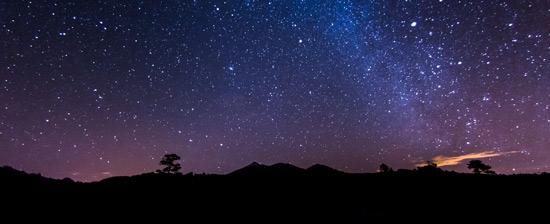
Here is a selection of the Starlight areas in Spain :
Sierra Sur District. (The Sierra Sur mountains in Jaén Andalusia, southern Spain). This is a landscape abounding in mountains and canyons where the air is clean and transparent. Different astronomy associations and the Andalusia Astronomy Observatory normally organise guided observation activities. There are even companies that provide private astronomy guide services at those country house lodges that have professional telescopes.
Andalusia Sierra Morena Mountains. There you will find a marvellous network of star gazing vantage points and accommodation. They also offer package holidays that include specialist guides, observation material, day and night activities, accommodation, 4x4 travel, etc.
El Montsec. This is a Starlight Tourist Destination located in the foothills of the Pyrenees in Lleida (Catalonia). You could do no better in this area than pay a visit to its large astronomy park made up of the Universe Observation Centre (COU) and an Astronomy Observatory. Did you know that the well known “Montsec Eye” is to be found there, the 12-m dome which opens out to bring you “face to face” with the Montsec sky?
Tenerife. Both the Teide National Park along with other mountain peaks on Tenerife and the town of Granadilla de Abona hold Starlight certification. If star gazing is exciting in itself, watching them from a volcano at over 2,000 m above sea level is an incomparable experience. What better place to gaze at the moon than from a lunar-like landscape? The geographical situation of the Canary Islands offers visitors a chance to observe both the northern and southern hemispheres. You can sign up for a guided visit to see inside one of the most modern telescopes in the world or to take a photograph of the night sky.
La Palma. Known as the “beautiful island”, this is the most rugged of the Canary Islands and the one with the clearest skies. It is definitely an understatement to say that this is one of the best places on earth to observe the stars. All the towns on the island have astronomy vantage points. Its famous Roque de Los Muchachos Observatory, standing some 2,400 m above sea level is one of the most complex telescopes, and indeed one of the most complete, in the world. You can visit it, but only by prior arrangement. La Palma has several hotels and country house lodges with observation instruments. There you will find sundials and even restaurants that offer “galaxies” and “constellations” among their dishes.
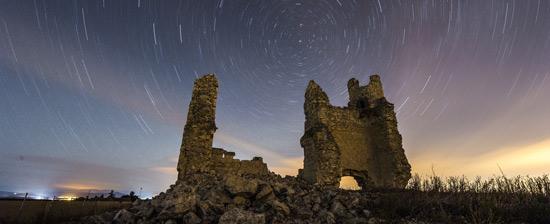
Gredos Norte. This is in the south of the province of Ávila (in Castile-León, inland Spain). It has a network of star watching vantage points that are equipped with information panels, car parks, etc. The Astronomy and Astrophotography Congress is held there every year.
Biosphere Reserve of the Valleys of Leza, Jubera, Cidacos and Alhama. We are talking about the beautiful countryside of La Rioja (northern part of inland Spain). Several activities have been organised there in recent years such as talks about the sounds of nature, tours to spot nocturnal birds, explanations on the link between the Celtiberian culture and the stars, bathing under the stars in thermal springs, learning about the constellations, etc. La Rioja also has two star parks: the Laguna one in Cameros and other in Cervera del río Alhama.
One of the most popular times of the year to stargaze in Spain is during what is known as the “Tears of Saint Lawrence”. They refer to the Perseids meteor shower of shooting stars that usually takes place between the 11 and 13 August every year. Not every night is suitable for sky watching on account of moonlight and wind factors however the best nights are those just before and after a new moon.
 2
Like
Published at 10:46 PM Comments (1)
2
Like
Published at 10:46 PM Comments (1)
The Library of San Lorenzo
Saturday, July 22, 2023
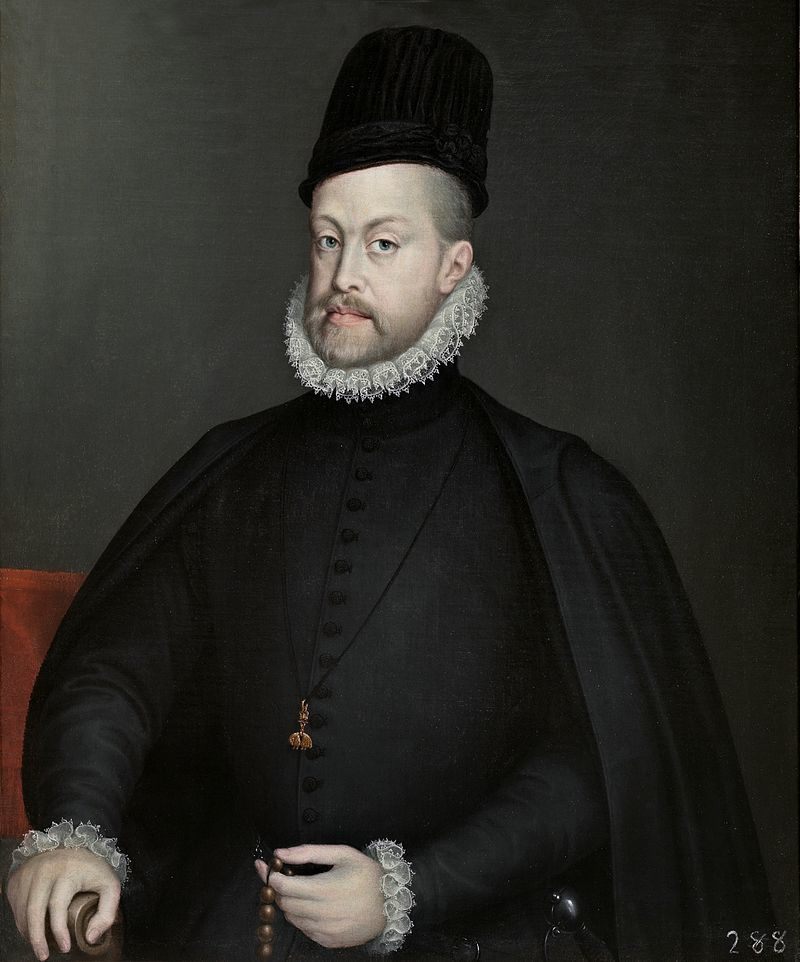 In the 16th century, King Phillip II of Spain wanted to build a library that would hold not only books and manuscripts of philosophy and theology but also instruments of scientific learning such as ornate globes and astrolabes, both celestial and terrestrial, and maps of the known world. In the 16th century, King Phillip II of Spain wanted to build a library that would hold not only books and manuscripts of philosophy and theology but also instruments of scientific learning such as ornate globes and astrolabes, both celestial and terrestrial, and maps of the known world.
In earlier times, this would have been considered heretical, but this new emphasis on unifying the humanities and the sciences was typical of the spirit of a new age in Europe, the so-called Renaissance, and so the magnificent Royal Library of San Lorenzo de El Escorial was built.
The library was designed by the mathematical and architectural genius Juan de Herrera, and it is notable for being the first library on the European continent to break from the medieval dogmatic beliefs on architecture and decoration. Indeed, it’s believed that the design and decoration of the Vatican library in Rome took its inspiration from Herrera’s work in El Escorial.
The plan for the space also influenced how libraries worldwide were to display their collections. It was the first institution to display its books and manuscripts in shelving cases along the walls rather than in bays that were placed at right angles. This was done so that the titles would be visible to visitors to avoid the damage caused to the books when they were taken out to view.
The enormous collection of over 40,000 books and manuscripts kept here cover everything from philosophy to politics to poetry, written in a multitude of different languages, including Latin, Greek, Italian, Spanish, Portuguese, English, French, Arabic, Persian, Hebrew, Chinese, and even Nahuatl, the language of the Aztecs. Colourful frescoes adorn the ceiling depicting scenes from classical history that represent what the ancients considered to be the seven arts: grammar, rhetoric, dialectics, arithmetic, music, geometry, and astronomy. Beyond the cornice, you will also find a total of 14 paintings that show scenes meant to encourage an appreciation for the arts in the visitor.
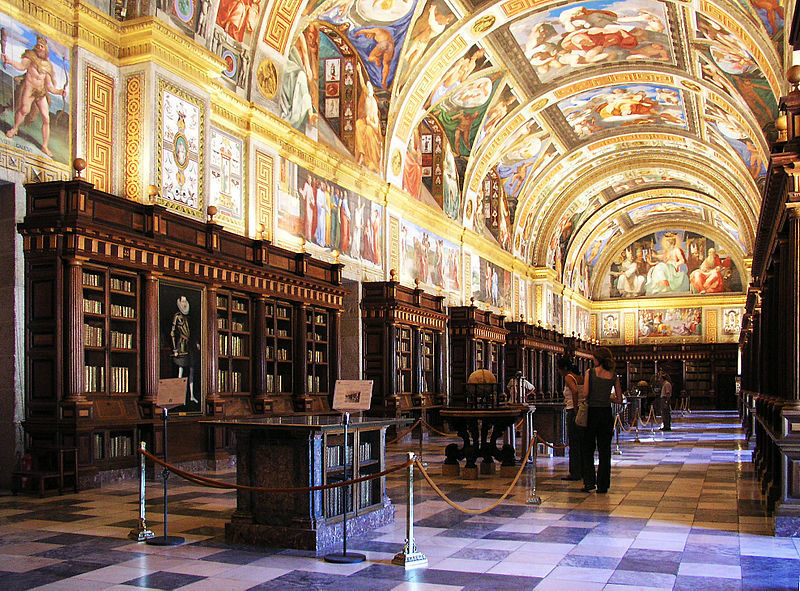
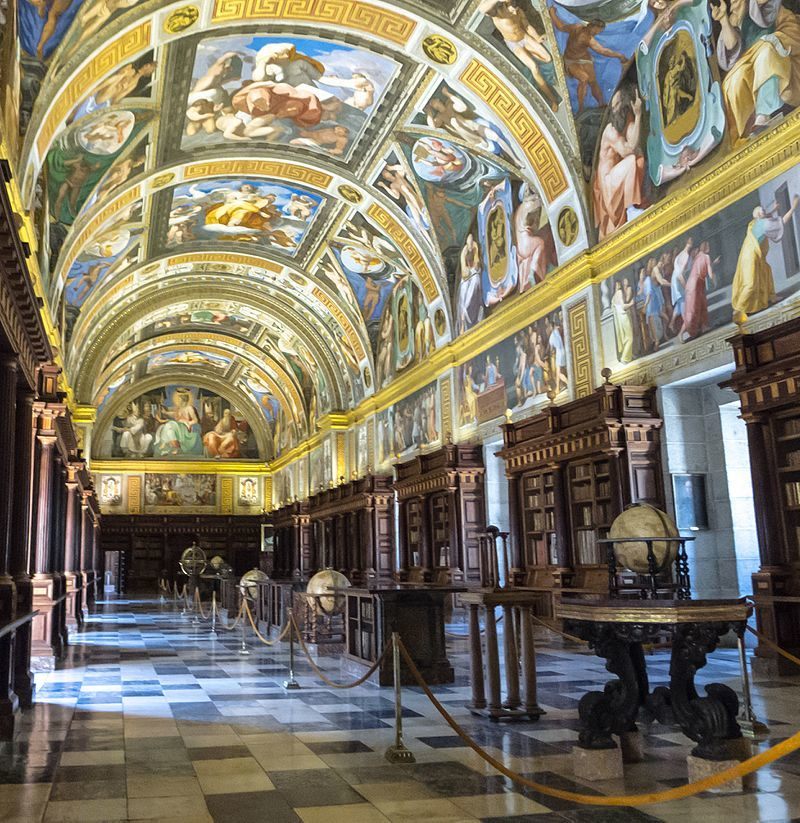
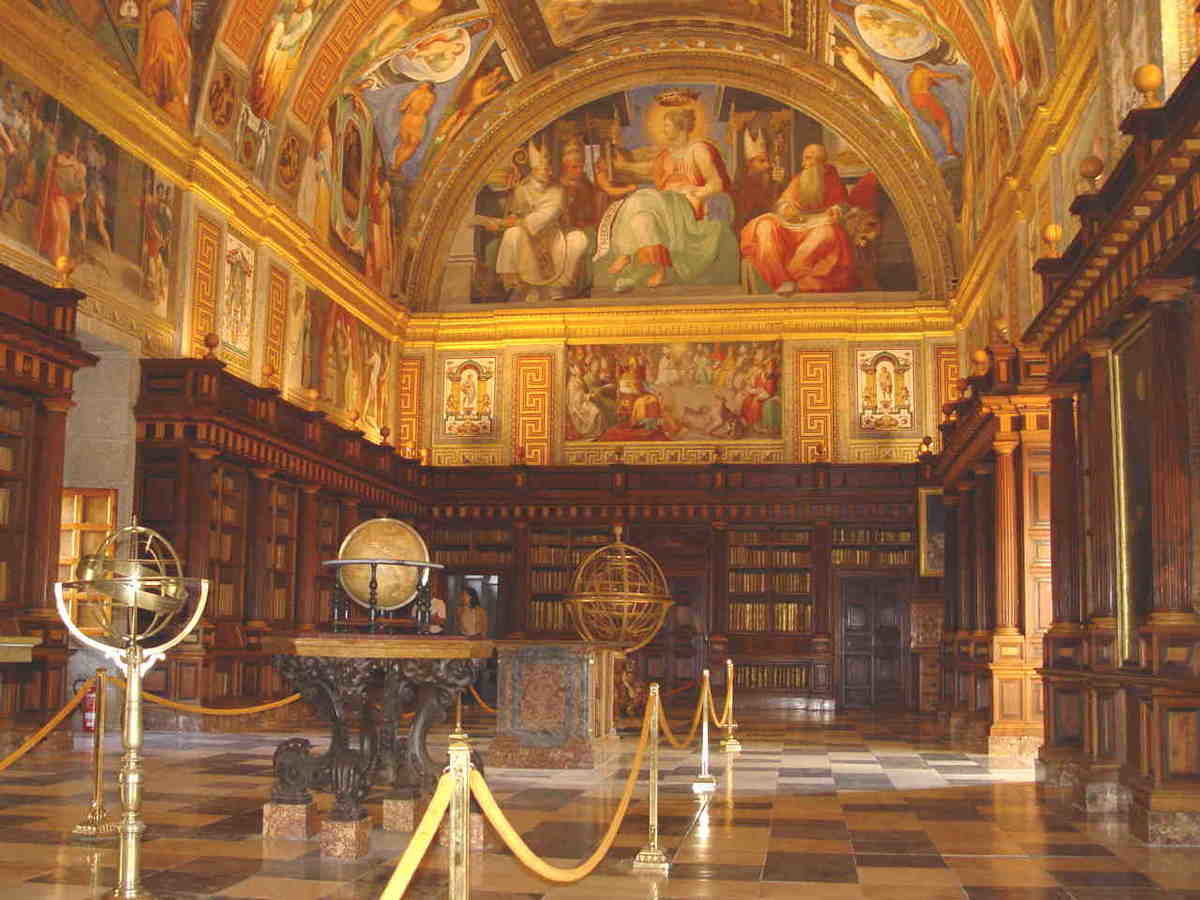
Among the most fascinating objects in the library are the numerous wonderfully baroque globes and armillary spheres, of which King Phillip evidently was an avid collector. It is said that the king would spend much of his time in the library studying these instruments in the company of astronomers, geographers, and cartographers.
The Royal Library (Real Biblioteca) is located within the monastery and palace complex in Lorenzo de El Escorial, outside Madrid. It is open from Tuesday to Sunday from 10 a.m. to 6 p.m. and the entrance fee 10 euros. El Escorial can be reached via public transport from Madrid. Simply take the Cercanias train (line c3) about a half hour from the Atocha or Sol station. Once you reach the station in El Escorial, it's a 30-minute walk to get to the palace, much of which is uphill so it can be quite a hike. Make sure you bring plenty of water and sunscreen if you visit in the summer.
 0
Like
Published at 2:39 AM Comments (0)
0
Like
Published at 2:39 AM Comments (0)
Cova Negra - Nature Park
Saturday, July 15, 2023
No trip to Xàtiva is complete without a visit to the nearby Cova Negra, declared a Municipal Nature Park in 2006. Located in a narrow valley that runs along the river Albaida, the park covers 57 hectares of spectacular countryside that is home to a wealth of ecological and heritage assets, including the Cova Negra archaeological site. Declared a Cultural Heritage Site, the cave is fundamental in understanding European prehistory and how the Neanderthals lived.
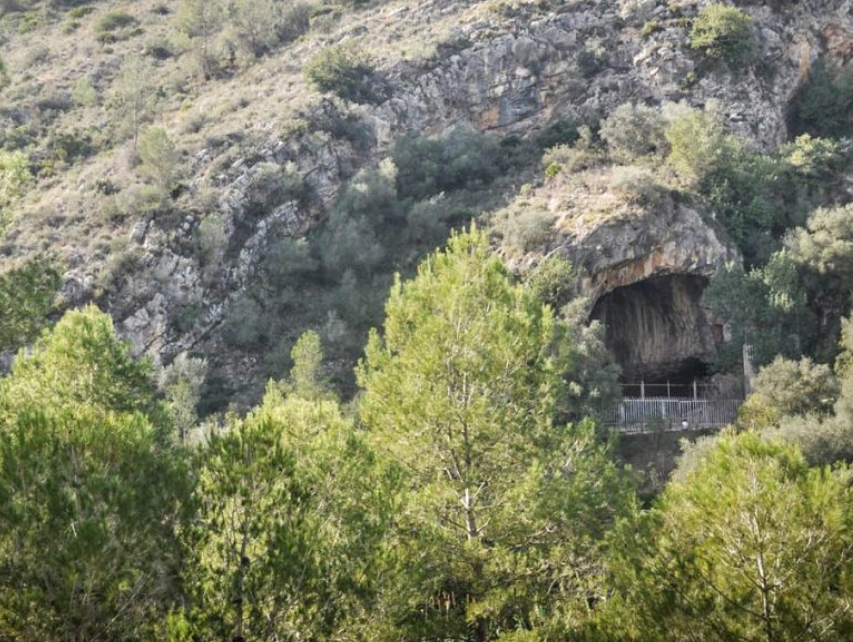
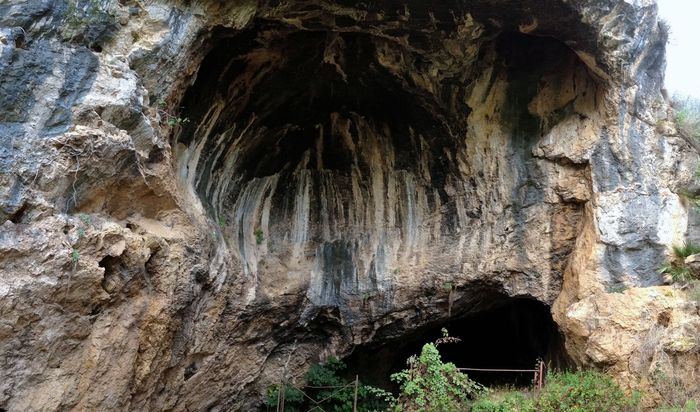
A ramble through the Cova Negra landscape reveals the contrast between riverside and mountain flora. The river Albaida hosts communities of floating plants and is lined by riverside woods containing mature poplars and elms. Meanwhile, the mountain area is perfumed with the seductive scent of Mediterranean flora, including many aromatic herbs such as pebrella (Thymus piperella), a species of thyme that is endemic to Valencia.
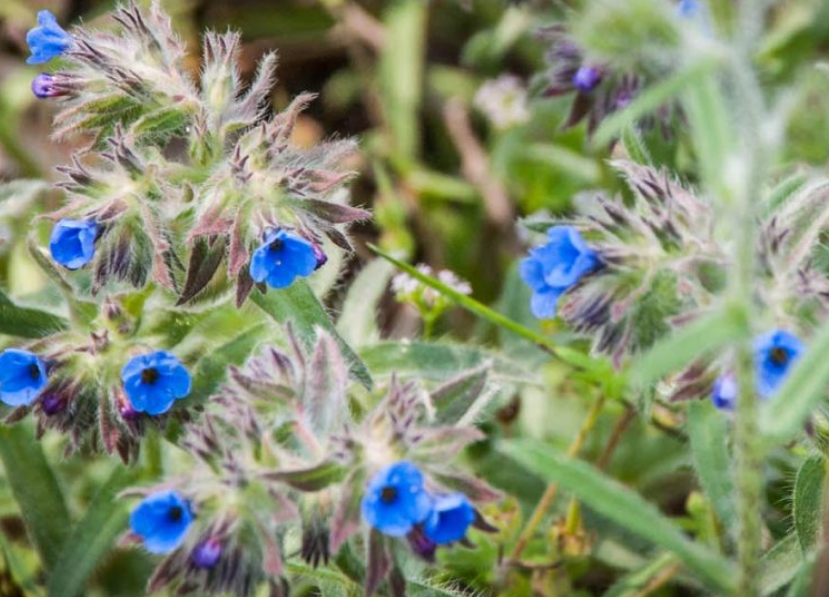
The Cova Negra is particularly rich in bird life, and patient observers may be treated to the sight of Bonelli’s eagles, grey herons, purple herons, kingfishers and peregrine falcons during their stroll. However, the park also hosts a wealth of other fauna.
At the widest bend in the river Albaida lies the archaeological site of Cova Negra, named after the dark colour of its walls and once home to Neanderthals during the Palaeolithic Era. Human remains and paintings have been found inside, and the site is of fundamental importance in understanding Mousterian culture and how the Neanderthals lived. An exact reproduction of a parietal bone (part of the skull) from the era that was unearthed in the cave is exhibited in the Almodí Museum.
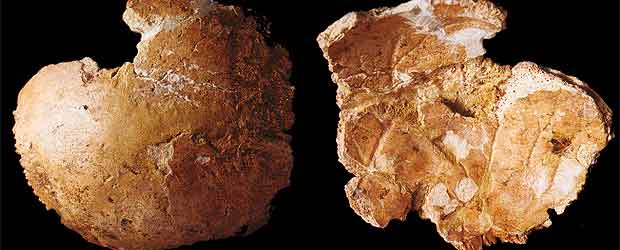
The region’s historical gem of hydraulic engineering, the Arcadetes d’Alboi aqueduct strides across the river Albaida on the way to Alboi. Of Gothic construction, although not yet documented, its nine pointed arches and two hundred metres of length stand testament to an earlier era when it supplied water to the city.

Les Arcadetes form part of the canal from Bellús to Xàtiva, a mediaeval watercourse that begins at the spring of Bellús. Listed as a Cultural Heritage Site at the beginning of century, it flows beside the Albaida River for ten kilometres. It is fascinating to seek out the respiralls, vertical, circular structures that connected the canal to the exterior during its underground sections. According to local legend, these were the brainchild of the intelligent daughter of the Muslim king of Xàtiva, and enabled water to flow along the entire route. However, her jealous brothers paid her for her ingenuity with death, an event commemorated by the two springs of crystalline water that then bubbled up at the site.
The Cova Negra park and the surroundings of Xàtiva in general are ideal for enjoying outdoor pursuits. Thanks to the numerous trails and paths that wind through the landscape, this is an unsurpassed area for hiking and mountain biking. Meanwhile, rock climbers will enjoy l’Aventador, a huge rock wall that has long been used for this sport.
 0
Like
Published at 2:01 AM Comments (0)
0
Like
Published at 2:01 AM Comments (0)
Cáceres, the heart of Extremadura
Friday, July 7, 2023
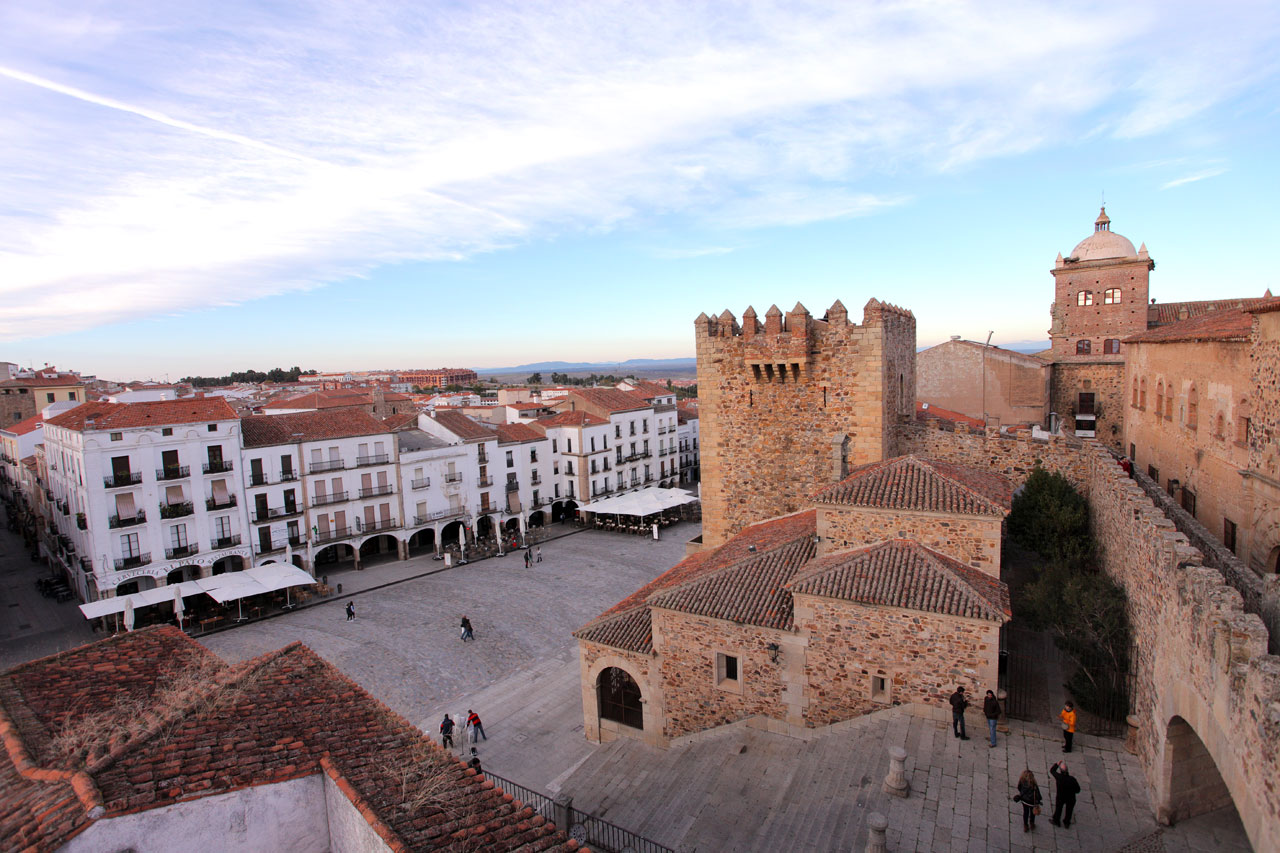
Cáceres is an outstanding city that was ruled from the 14th to 16th centuries by powerful rival factions: fortified houses, palaces and towers dominate the views of the city. This city, in the heart of Extremadura, bears the traces of highly diverse and contradictory influences, such as Islamic arts, Northern Gothic, Italian Renaissance, arts of the New World, etc. The walls of the city bear exceptional testimony to the fortifications built in Spain by the Arab Almohads.
Caceres or Caesarina, its name in the 6th century, played only a minor role in the Visigothic Kingdom. It had lost almost all its prominence when the Arabs seized it and made it a fortified city, called Qasri, which in the 12th century Al-Idrisi saw as the principal bridgehead against the Christians. Moreover, during the 12th-century wars, after the Almohads had lost and then retaken the city several times, they built remarkable fortifications which completely changed the appearance of the Roman walls which had marked the boundaries of Caesarina, although few example of these walls are still visible today. Flanking towers were positioned externally a few metres from the rampart and connected to it by a wall; five of the towers, rectangular in shape, still stand to the west, including the famous Torre del Bujaco; two polygonal towers can be seen to the south (Torre Redonda and Torre Desmochada); to the east, the Torre de los Pozos, rising 30 m above the rampart walk, is partly built into a barbican.
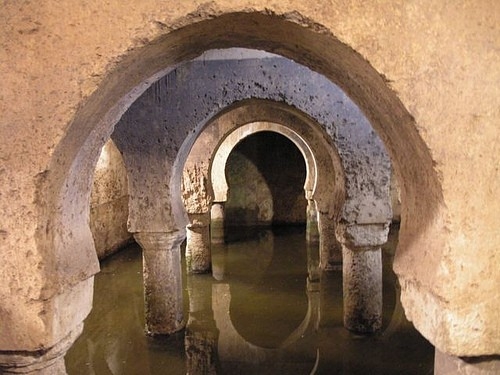
Few monuments have survived from the Muslim period within the walls, however the most significant is the five-nave reservoir with three bays, incorporated into the Casa de las Veletas in the 16th century. Although most of the monuments have been lost (the site of the Alcázar was parcelled out in 1473), the pattern of the streets, with winding backstreets that open on tiny squares or turn into narrow alleys, is a survival from urban planning during the Almohad period. The number of patios and interior gardens also bears testimony to the influence of Qasri on Cáceres.
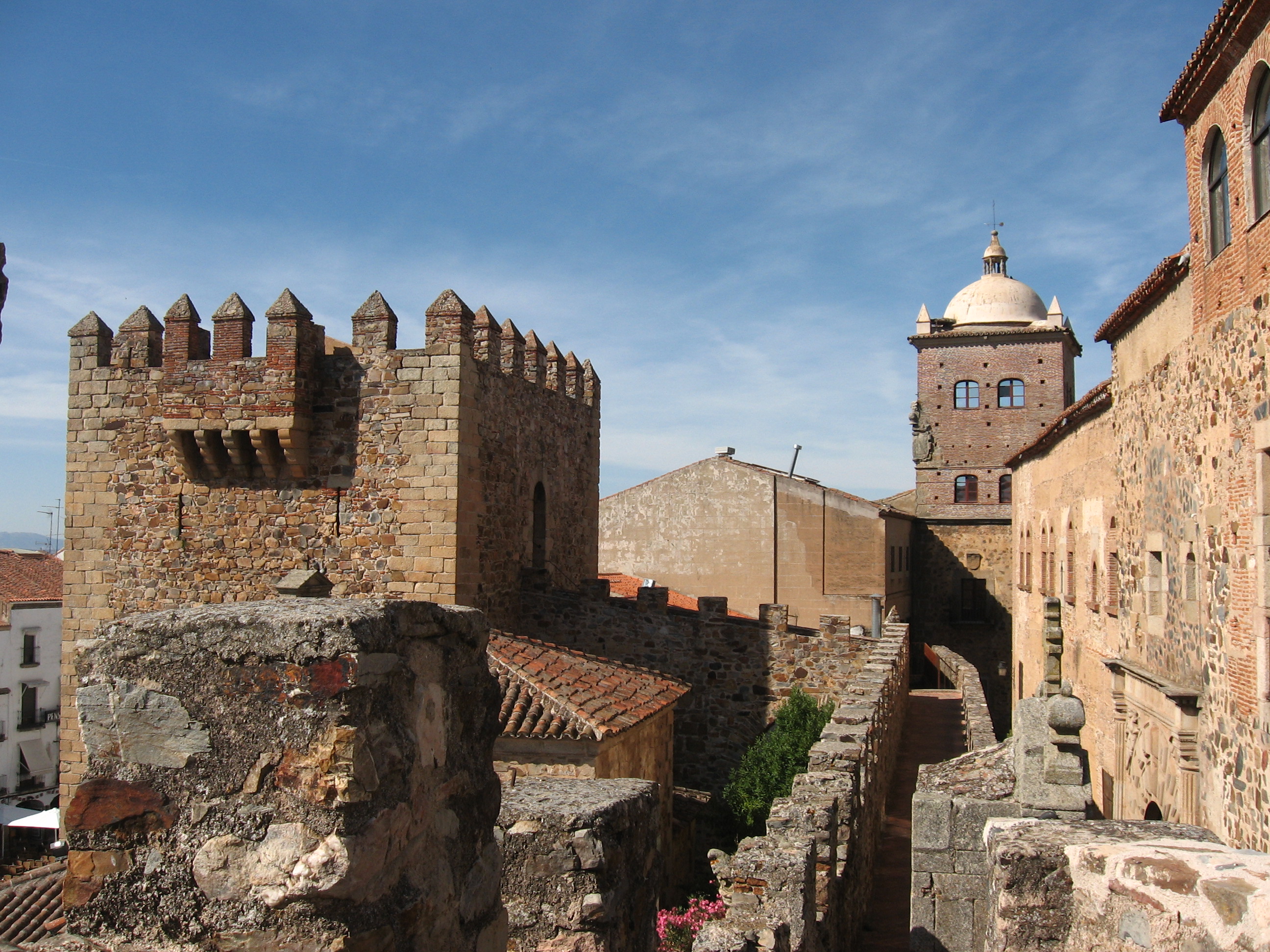
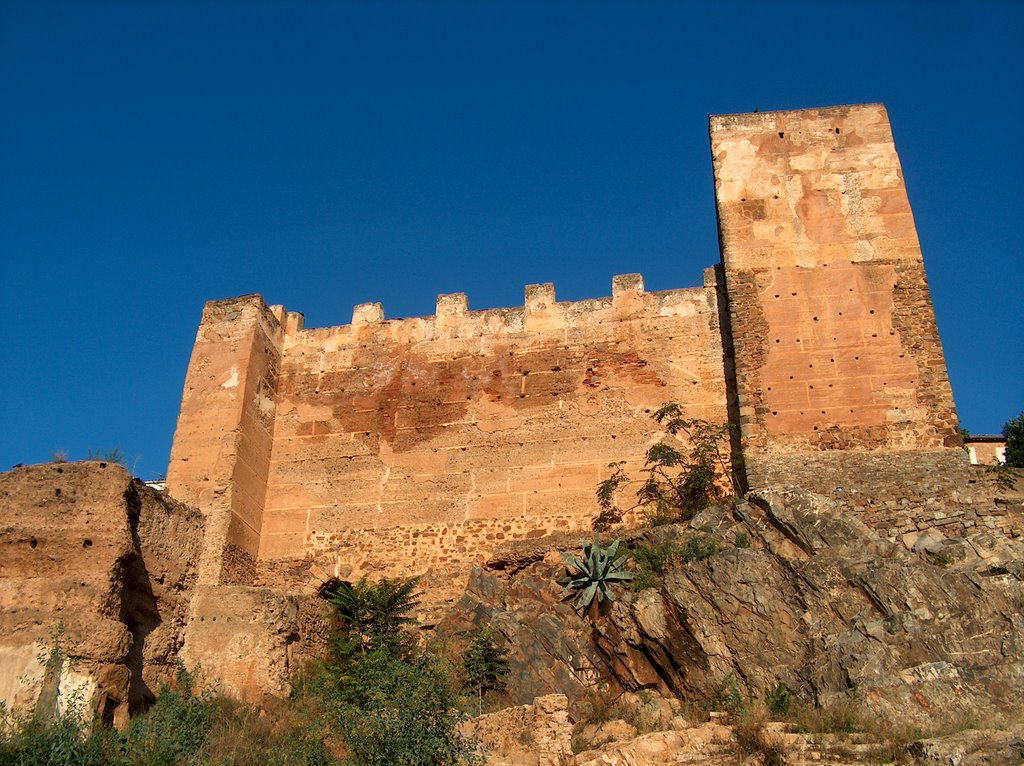
Alfonso IX, King of León, recaptured the city from the Moors in 1229. The destiny of Cáceres shifted again in the 14th century with the massive influx of noblemen who had initially been excluded from repoblación as a result of measures imposed by Alfonso IX. In the space of a few decades, fortified houses dotting the landscape made the city a perfect example of a feudal city, which since 1312 had been the stage for power struggles between rival clans. Notable among the oldest seigniorial fortresses are the Palacio de la Generala, the house and tower de las Cigüeñas, Casa de Los Ovando-Perero, Torre de Los Espaderos, and Casa Espadero-Pizarro or Casa del Mono.
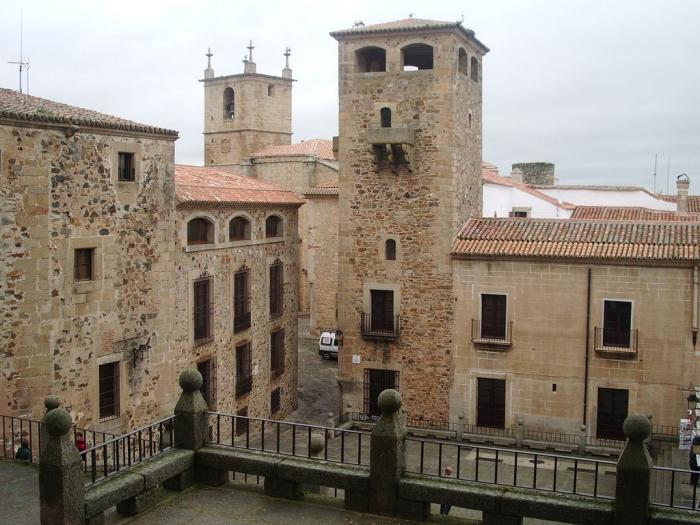 In the 15th and 16th centuries, noble pride was demonstrated by richly decorated coats of arms and a surge of towers, battlements and fortified residencies. The Catholic Kings tore down most of these unusual constructions but preserved some in deference to the wishes of a few select noblemen (e.g. Palacio de Los Golfines de Arriba, Palacio de las Cigüeñas). Only their smaller proportions and a more modest system of defence distinguishes the city's exquisite stone houses from the palaces (Casa de Aldana, Casa del Sol, Casa del Aguila, Casa de Ulloa, Casa de Carvajal, etc.). When the 'Americans' returned, new palaces were constructed: Palacio Godoy, built by a newly rich "conquistador" and Palacio de Los Toledo-Moctezuma, built in the second half of the 16th century for the grandson of the Aztec who had greeted Cortes when he reached Mexico. In the 15th and 16th centuries, noble pride was demonstrated by richly decorated coats of arms and a surge of towers, battlements and fortified residencies. The Catholic Kings tore down most of these unusual constructions but preserved some in deference to the wishes of a few select noblemen (e.g. Palacio de Los Golfines de Arriba, Palacio de las Cigüeñas). Only their smaller proportions and a more modest system of defence distinguishes the city's exquisite stone houses from the palaces (Casa de Aldana, Casa del Sol, Casa del Aguila, Casa de Ulloa, Casa de Carvajal, etc.). When the 'Americans' returned, new palaces were constructed: Palacio Godoy, built by a newly rich "conquistador" and Palacio de Los Toledo-Moctezuma, built in the second half of the 16th century for the grandson of the Aztec who had greeted Cortes when he reached Mexico.
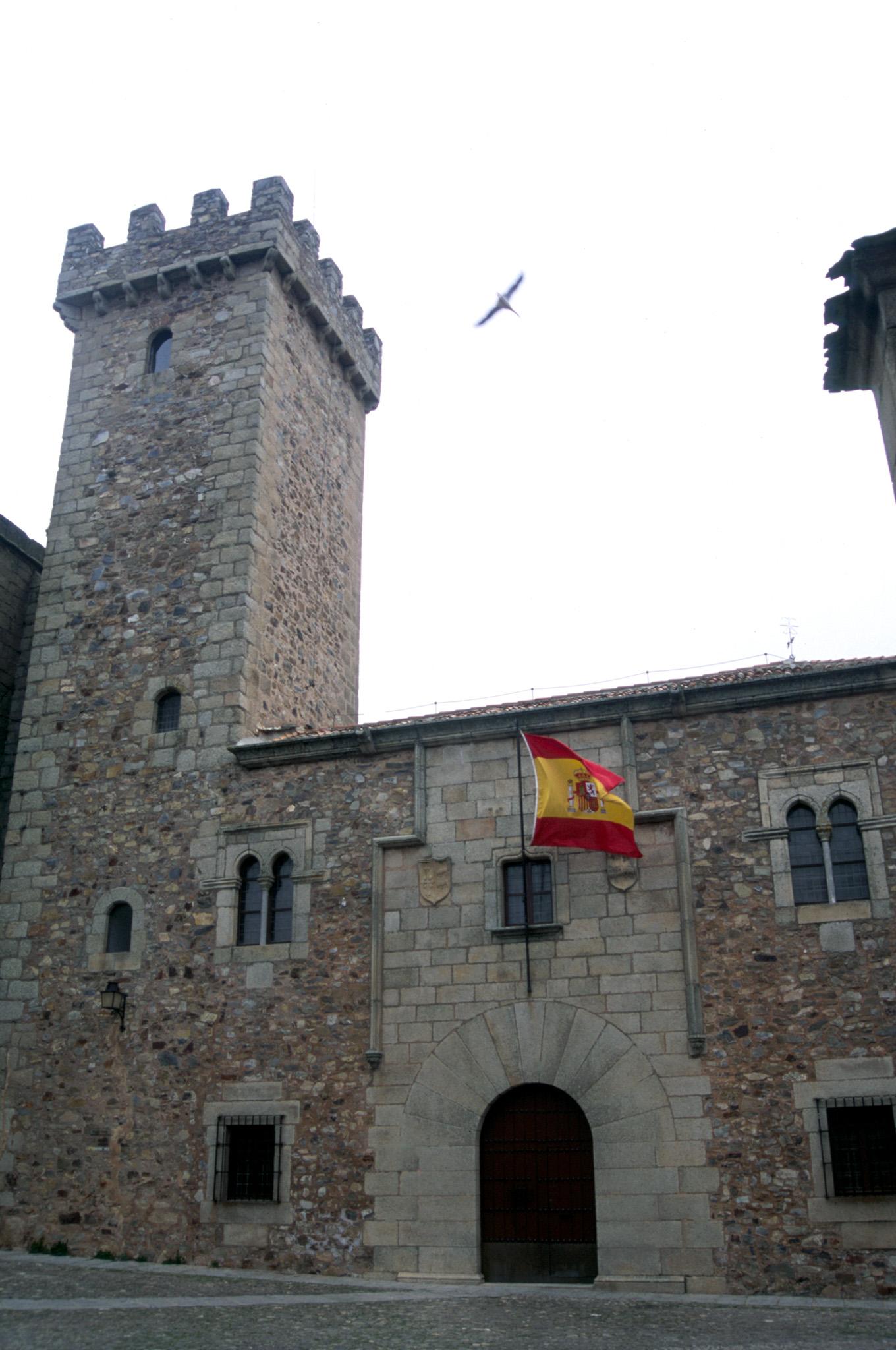
As always it's not all just about history and when visiting a city one must eat, fortunately, Caceres is also a wonderful city in gastronomic terms. The gastronomy of Caceres and the province of Extremadura is flavourful and varied, in which the Ibérico pig plays a major role, thanks to the quality of the processed meat products made in the region. Roast, stewed lamb, a variety of freshwater fish and game dishes are examples of the sobriety of Extremaduran cuisine. The vegetables produced in this region are also of widely recognised quality, particularly the asparagus and thistle greens. Among the fruits, apples, peaches and cherries from the Jerte Valley are worthy of special mention. Extremadura produces a type of cheese that is unique in Spain, the so-called tortas. With two Designations of Origin, PDO Torta del Casar and PDO Queso de la Serena, these are cheeses with a light, creamy texture and powerful flavour, some of Spain's most unusual. Honey, dried fruits and pastries such as 'perrunillas' (sweet biscuits made with anise) or técula-mécula (a rich almond cake) are all magnificent desserts from Extremadura.

Ver mapa más grande
 4
Like
Published at 11:58 PM Comments (0)
4
Like
Published at 11:58 PM Comments (0)
Spam post or Abuse? Please let us know
|
|